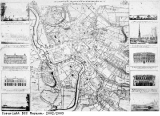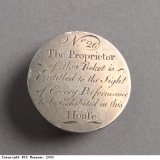The Growth of the City
Bristol grew throughout the 18th century. It was a wealthy city. That wealth came from several trading areas. Bristol was involved in the ‘triangular trade’ to Africa and the Americas. The city also traded directly to the European-owned colonies in the Americas, as well as with Europe itself. The profits from these trading ventures all helped to fund the building of gracious houses and public institutions, such as the library and theatre. Pictured here is a silver pass for the Theatre Royal in Bristol, from 1766. The 50 sponsors of the new theatre included many with direct or indirect links to the slave trade.
Those merchants involved in the African, Caribbean and American trades were the very people living in the grand houses and sponsoring the public buildings of Bristol during this time. The Slave Trade Trail around Central Bristol demonstrates this, showing which buildings and houses can be linked to the slave trade. (This trail is published in a leaflet format, for details see the Bibliography in the Learning and Resources section of this site. The trail can also be viewed on a website, which can be found through External Links in Learning and Resources).
Sir Dalby Thomas (author of An historical account of the growth of the West Indies collonies, and of the great advantages they are to England, in respect to trade, published in 1690) was quoted in 1745 as saying “The pleasure, glory and grandeur of England has been advanced more by sugar than by any other commodity…”. This was certainly true in Bristol. For example, the merchant John Pinney made his money from slave-produced sugar. He owned plantations on the Caribbean island of Nevis which produced sugar, and from Bristol he ran a sugar importing business. He built 7, Great George Street for himself, a comfortable town house of the period (the building is now called the Georgian House and is a period house museum). His son Charles inherited a fortune made from sugar and increased it. Charles moved away from the noise and smells of the city where his father had lived. He moved to the rural edge of Bristol and built himself the grand Camp House on the Promenade. There were several other plantation owners and sugar merchants in Bristol. Thomas Daniel was one of the biggest sugar merchants. He was so rich and powerful he was known as ‘the King of Bristol’. John and George Daubeny ran one of the sugar refineries (or sugar houses), in Halliers Lane. Many of these sugar merchants were important men in Bristol. Their wealth gave them a position in the political, social and charitable life of the city.
The 18th century saw Bristol grow rapidly. The population in 1701 was about 20,000. By the end of the century it had risen to about 64,000. The rise was probably partly due to the new work available in the city. Bristol merchants were importing increasing amounts of sugar and tobacco from the European-owned slave plantations in the Americas. These raw goods had to be processed before they could be sold. The growth of new industries in Bristol to process the goods meant new jobs, and people moved in to the city to find work.
The city also grew because the increasing wealth from trade, including the slave trade, meant that there was money to invest in new buildings. Many new houses were built in streets and squares. Men enriched by slave or sugar trading could build themselves comfortable town houses or grand country houses. For more about this see the Profits section. Some of the houses in Bristol’s grand Queen Square (built between 1700 and 1718) were built by people linked to the slave trade. For example, James Woodes Rogers who lived in the square invested money in slaving voyages. The Elton family, also of Queens Square, supplied brassware for the trading cargoes which were used to buy slaves in Africa. They also invested in slaving voyages. John and Nathaniel Day were involved in slave and sugar trading. Others with links to the slave trade living in Queen Square at various times included John Anderson, Isaac Hobhouse, Joseph Jefferis, Henry Bright, Thomas Freke, James Laroche, John Becher, Lewis Casamajor, Joseph Earle, Abel Gant, John Gresley, Nathanial Foy, Thomas Harris, Noblett Ruddock, Elias Vanderhorst and Thomas Quirke.
At the end of the 18th century, there was a great deal of building by developers. The crescents of houses in the genteel suburb of Clifton were started at this time. The financial crisis that hit Britain in 1793 was started by inflation and made worse by a war with France. Many of the developers in Bristol, building with borrowed money, went bankrupt. Something like 500 houses were left in different stages of completion. They were not completed until the general economic climate improved. Building recommenced in 1805, but the last unfinished houses were not completed until 1820. After this time, Bristol continued to grow, expanding out into the surrounding countryside.
It was not just the housing in Bristol that developed. Comparing maps of the city at different times shows that industry was also expanding. The 1673 map of Bristol drawn by Millerd can be seen here and compared with the 1742 map by Rocque, also shown here. The buildings where glass was made, called glass cones, and the buildings in which sugar was processed, called sugar houses, start to appear on the later maps. Both industries were linked to the slave trade. Glass bottles were needed for the brandy traded to West Africa to exchange for slaves and the beer, wine and cider traded to the Caribbean plantations. Glass bottles were needed for the rum which was brought back from the Caribbean (it was made as a by-product of the sugar processing which they did there). Glass decanters and drinking glasses were also traded. They were seen as status symbols in West Africa and were used by the plantation owners in the Caribbean. Sugar houses developed in Bristol as the trade in raw sugar from the Caribbean islands increased. Trade and industry generally flourished in the city. The trade with Africa required assorted manufactured goods used by the slave traders to buy enslaved Africans from the West African traders. What could not be produced locally, like cotton cloth and glass beads, was bought in from elsewhere in Britain or from abroad.






